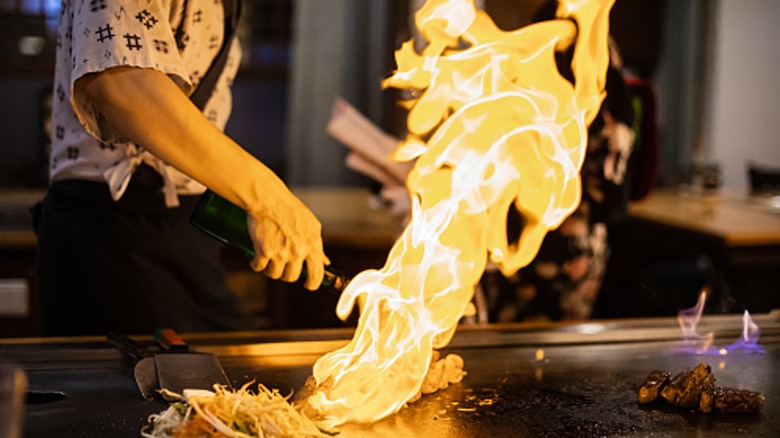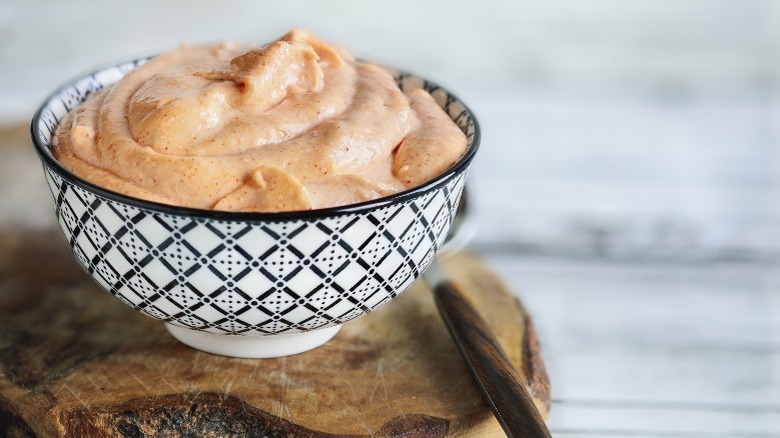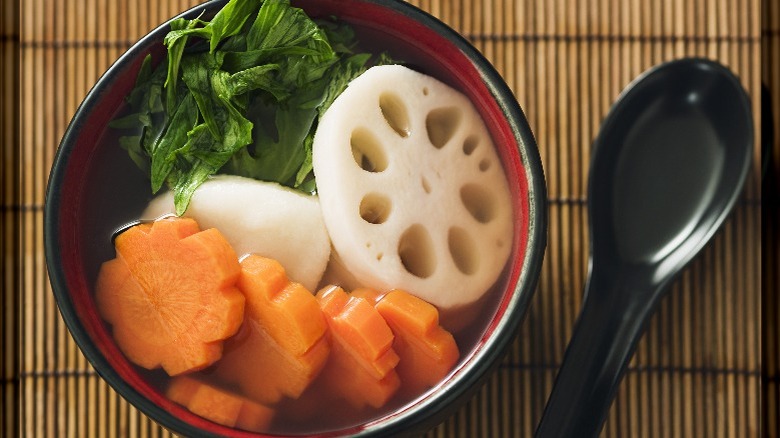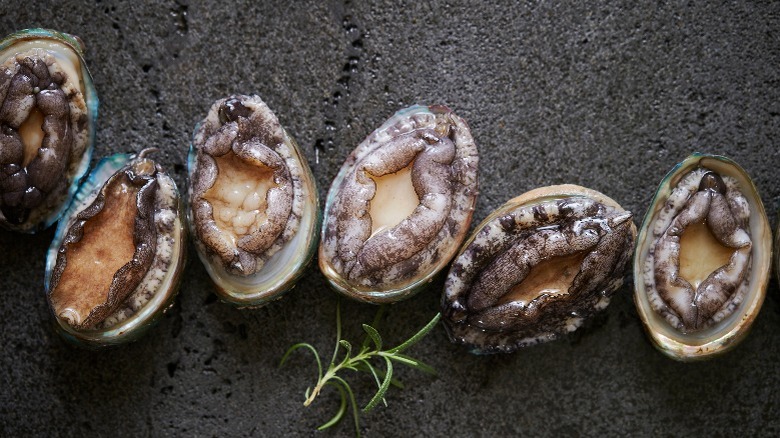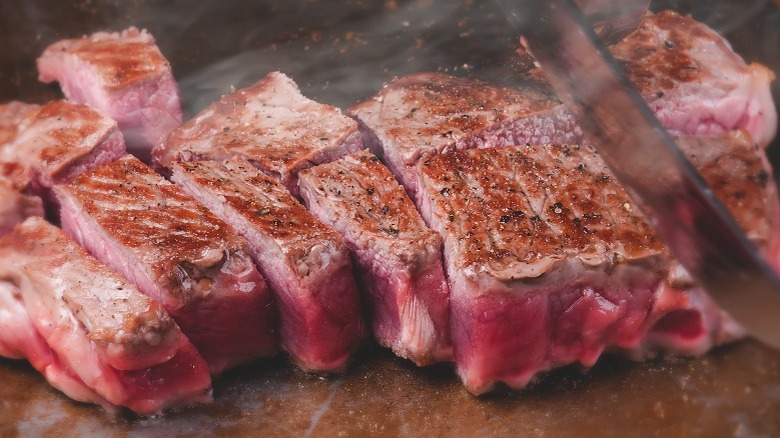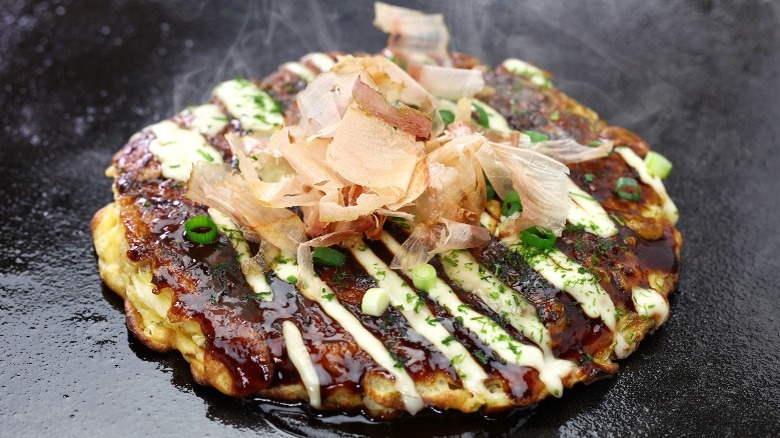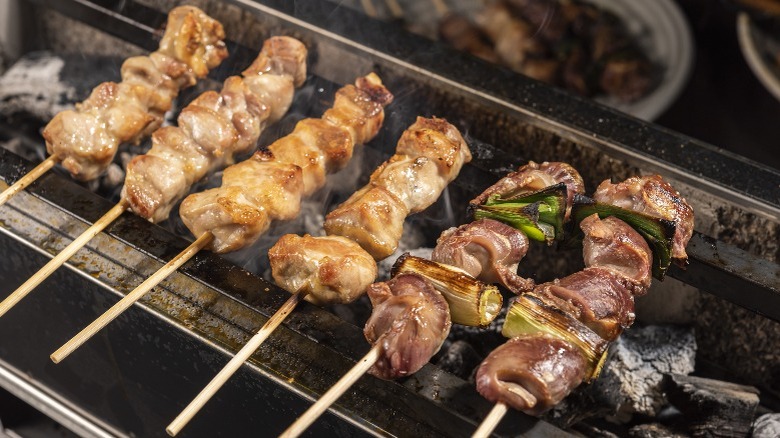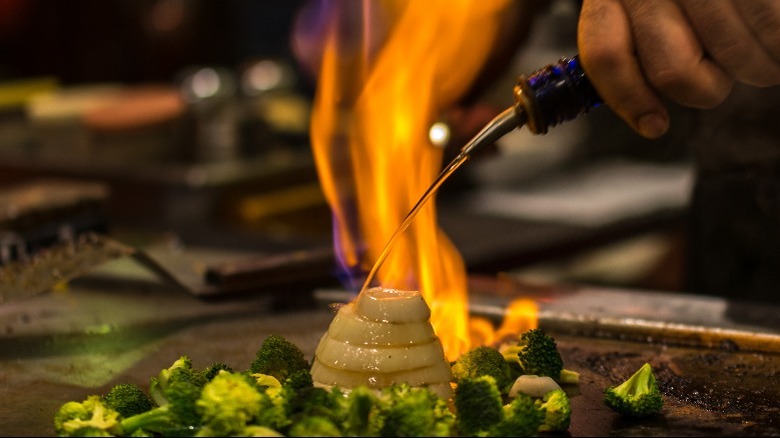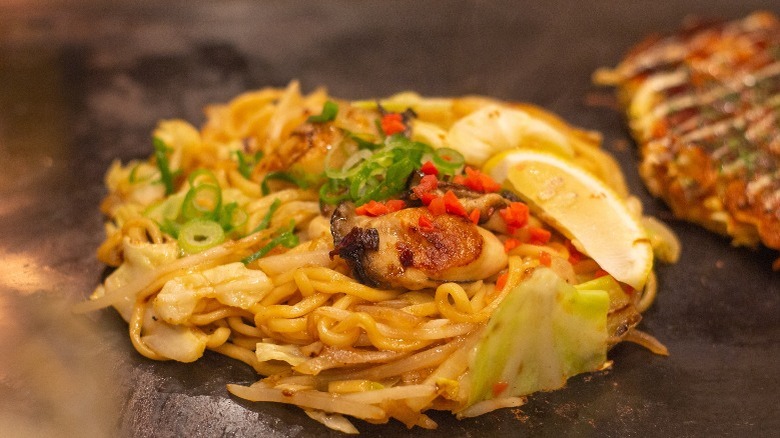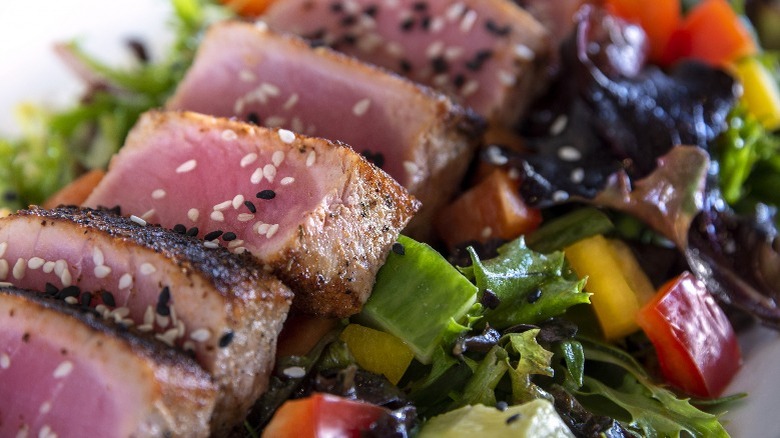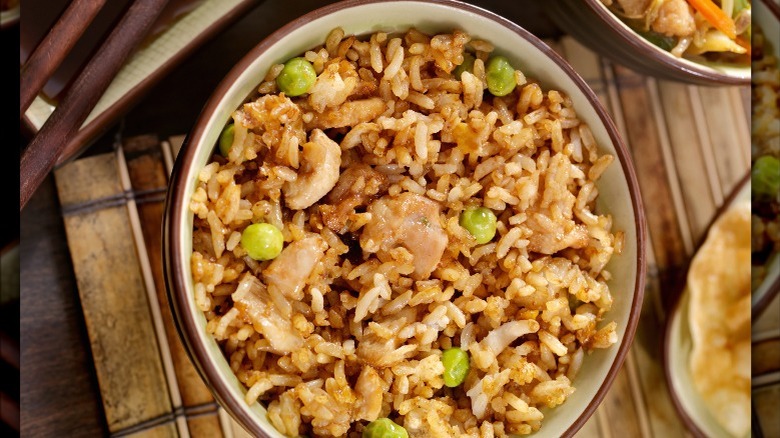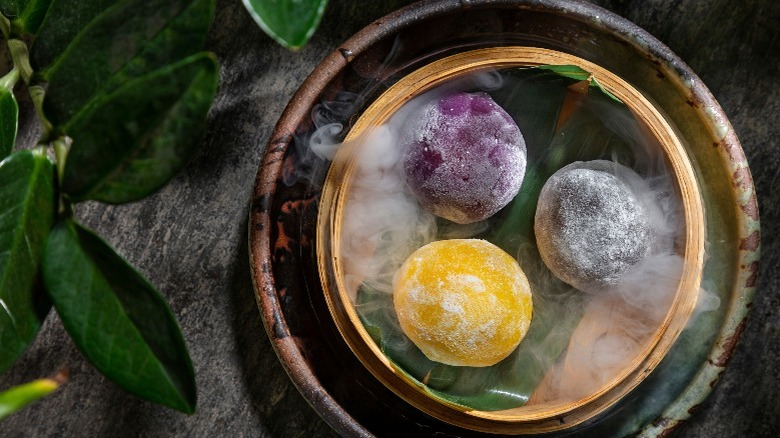15 Best Dishes You Can Find At A Japanese Steakhouse
The thought of a Japanese steakhouse might bring to mind the ubiquitous Behihana, but they've grown to include more delicious options and, occasionally, less spatula and knife-juggling. Not that we mind the tricks. Also known as teppanyaki restaurants, these places specialize in a hybrid American-Japanese style of cooking that takes place mainly on a large grill right at your table.
In Japanese, yaki means grilled, and teppan is the word for the metal plate where the grilling takes place. Teppan grills are large metal plates heated with propane and aren't the same as a hibachi (which means fire pot), even though the two are often used interchangeably in North America.
The original teppanyaki was brought to America by Rocky Aoki, who was a character worthy of his own deep-dive. Aoki was all about showmanship and living large which made him the perfect person to bring not just shrimp-flipping but truly tasty hybrid food to the North American audience. While his style of steakhouse isn't to everyone's taste, the food he introduced was a hit. Developed in post-World War II Japan to suit the tastes of the influx of American soldiers, restaurant owners began developing dishes that incorporated flavors from both cultures. It was such a hit that it eventually made its way here with great success.
Yum-yum sauce
Created by Japanese steakhouses for the American palate, yum-yum sauce is easily one of the most delicious things you can put on steak. Also called shrimp or white sauce, it's a sweet, tangy, creamy condiment that actually goes well with nearly everything it touches, from protein to veggies (it's an absolute dream on asparagus, darlings).
Calling it white sauce is a bit of a misnomer, as you can see. Most recipes include a bit of tomato paste that will give the mayo-based dip that lush pink tint, as well as a little boost of umami. If you're craving your own bowlful for slathering right now but can't get to a teppanyaki restaurant, it's actually pretty easy to make at home. You can always buy it but trust us, the storebought versions are never as good. Most steakhouses make theirs in-house, and it's so simple that you can, too. Lucky for you, we have a terrific recipe that can be tweaked to your heart's desire.
Ginger sauce
The other condiment you need to try is the umami bomb known as ginger sauce. In fact, some diners swear by the combination of both ginger and yum-yum sauce on dishes like garlic fried rice or grilled veggies for the ultimate in eating.
A little more traditional than yum-yum sauce, this ginger and soy-based dipper still has loads of flavor that work really well with the offerings at a Japanese steakhouse. This zippy little stunner goes well on everything, honestly. Shrimp and steak, gyoza and egg rolls, all the vegetables you can shake a fork at — they'll all get even tastier if that's possible (it is!). Made from a simple combination of fresh ginger root, yellow onion, brown sugar, soy sauce, and rice vinegar, it has a deeply savory flavor that really does work well with most menu items. Some restaurants may also add lemon juice or green onion for extra zip.
Clear soup
Known as "osuimono" (meaning "something you can sip"), this clear soup is healthy, tasty, and one of the most common foods in Japan. Both miso and osuimono soups are eaten with most meals on a daily basis, so it stands to reason that it makes an appearance in teppanyaki restaurants. Clear soup doesn't contain any miso and instead has a lighter flavor courtesy of katsuobushi (dried bonito) that focuses on the simple perfection of the ingredients.
In a teppanyaki restaurant, you'll likely find that your clear soup only has a few stunning additions, such as flower-shaped carrots, vibrant green spring onion, or a few slices of meaty shiitake. Clear soup is meant to be a very nourishing way to warm up during cold weather without getting too full to finish the rest of your dinner. Seated at a grill filled with so many delectable morsels, that's likely a really good thing, too.
Abalone
Abalone is one of the most prized ingredients in sushi as well as in teppan cuisine. If you enjoy seafood and find yourself in a restaurant that carries abalone, you might want to give it a try. While it's a gastropod and not shellfish (it comes from a large marine snail, actually), it is prepared and served in much the same way. Known as awabi in Japan, the best grilled abalone is cooked live for ultimate freshness, so keep that in mind before you order, just in case that's something that might put you off.
The strong muscular foot is the part that is most prized and is generally what you'll be served when you order this dish. However, if you see dishes using abalone liver, you should order that, too. The liver from these particular snails is often removed and puréed into a sauce that goes exceedingly well with pasta or drizzled over the grilled abalone.
Lobster
Another live component to your teppan experience, lobsters are best when as fresh as possible. However, in this case, the lobster is usually prepared in the kitchen before being brought out to the grill, so don't fret if you're a little squeamish.
Generally speaking, the way most steakhouses prepare lobsters is the same. First, it's placed under a metal dome to steam before the meat is removed from the shell. Next, the chef will add both oil and butter to the meat while grilling and cutting it into bite-sized pieces. Depending on your order, seasonings might be added, and the meat may be scooped back into the tail for serving. Possibly the best part of lobster teppanyaki? Those incredible knife skills also mean that the chef will definitely retrieve as much of the meat as possible without you having to do any work.
Kitsune garlic
You may have tried fried garlic in the past, but until you've had the crisp, deep-red garlic slowly grilled to perfection, you've been missing out. Like caramelized onions, kitsune garlic (kitsune means fox in Japan, and the burnished orange shade is reminiscent of fox fur) takes patience and time. But the results are worth it if you love garlic the way we do. Thinly sliced and gently grilled until it achieves a glorious finish, you can eat it just as is, but feel free to liberally add it to anything else you order.
While ordering fried garlic in any teppanyaki restaurant is a good idea, if you can find kitsune garlic, definitely order some. The depth of flavor achieved through the low and slow cooking process makes all the difference here, bringing out the sweetness and tenderness while still giving you the crunch you desire. A bite of garlic with some perfectly grilled beef is unlike anything we've ever experienced, and that's barely even hyperbole. It also makes a magnificent upgrade to garlic rice.
Beef
Here's the menu item we've all been waiting for — beef. There's a reason that Japanese steakhouses, or any steakhouse for that matter, are so popular here, and it's not the fried rice or grilled asparagus. When Rocky Aoki dreamt up the idea of bringing teppan-style cooking to America, he knew what we wanted: showmanship, beef, chicken, and shrimp.
In a country that loves its beef like we do, steak has to be awesome to impress. And that's usually what you'll get at a typical Japanese steakhouse because they also know their beef. Wagyu is the umbrella term for Japanese beef that includes the four major purebred cattle types — Kuroge, Akage, Nihon Tankaku, and Mukaku — and this is often what you'll find on the grill here. Recently, however, Japan has started farming Angus beef as well, so you may find that on offer, too.
Okonomiyaki
Okonomiyaki is a great option at teppanyaki restaurants because it's a grill-specific dish (it's even in the name, y'all). Made from a base of cabbage, eggs, and flour (or occasionally breadcrumbs), this tasty grilled savory pancake can be dressed up with anything you fancy because "okonomi" does mean, after all, "as you like."
Crispy on the outside and tender on the inside, you can add whatever tickles you, including pork belly, bits of squid or shrimp, more veggies like corn or green onions. Once grilled, the pancake gets slathered with mayo (or more of that yum-yum sauce) or hoisin and sprinkled with toasted sesame seeds, bonito (dried salted fish) flakes, and more green onion. If you have a decent grill at home and just can't wait, we can help with this simple recipe. Okonomiyaki is a classic Japanese food that is eaten often so give it a try if you're looking for something more traditional.
Yakitori
Yakitori is a well-known snack food in Japan, served nearly anywhere that has space for a small grill, including the tiny pubs known as "izakaya" ("stay-drink-place") and street stalls. While it's most often made with chicken, you can also find beef or liver as well. Composed of small pieces of marinated meat threaded onto skewers, yakitori has a distinct taste from the grilling process that makes it so popular.
In a teppanyaki restaurant, it's unlikely for them to use the traditional grill, instead choosing to cook the skewers directly on the hot iron plate. The difference likely won't bother you if you're not a true yakitori connoisseur. True yakitori grilling imparts a lovely smoky flavor that you won't get with a teppan griddle, so if you want to seek out the true experience, it's become a bit of a trend in restaurants recently, so it can be worth finding a place using the traditional konro grill. The recent trend also means that you might find far more flavor options than you once did, too.
Shrimp
Even if your chef doesn't flip the empty tail into his hat, teppanyaki grilled shrimp is another pleasing order. Serving up a few different sizes of shrimp, most steakhouses will have a number of options for you if you're in the mood for a little crustacean action.
Shrimp prepared on a teppan grill is a relatively healthy option, too. They don't need a load of oil, and many restaurants actually cook them with steam instead of frying. It will also appear in many items on the menu, so if you love it, you'll be in shrimp heaven. Appetizers like shrimp dumplings are always popular, and you can add them to nearly any dish you order. One of the most popular tricks by Japanese steakhouse chefs is to quickly flick their spatula and launch a cooked shrimp directly into a customer's mouth, so be prepared for that, too.
Onion volcano
What about the ubiquitous onion volcano that seems to be the hallmark of these establishments? Sure, they may get maligned for being just a simple trick to amuse diners, but if you've ever seen it done, it's actually quite artful as well. In order to make an onion volcano, the chef stacks rings of sliced onion on top of one another very tightly before dousing the whole thing in alcohol, most often vodka or sake.
Once lit, the flames shoot out the top like an actual volcano, albeit a pretty simple one. A few grinds of fresh pepper add some sparks for a shimmering effect that diners absolutely love. Some chefs will even go so far as to extinguish the flames with their spatula and then perform some pretty cool tricks with the billowing smoke. And at the end of all that, the resulting deep char on the onion slices is rather tasty, too.
Yakisoba
Yakisoba is a noodle dish that's a must-try in Japanese steakhouses because the stir-fried preparation is perfectly suited to the hot iron plate, like fried garlic rice. The dish can incorporate any veggies and protein that you might crave, with cabbage, onion, scallions, and mushrooms being typical. The noodles used in yakisoba are similar to the kind you find in ramen — a wheat-based, alkaline version historically used in Chinese cooking. The alkalinity of the noodles gives them a characteristic yellow hue, as well as that toothsome chew that makes them so palatable. It also helps the dish stand up to the high heat of the grill while remaining supple.
The sauce used to dress the dish is also specific, and it uses a couple of surprising ingredients. First, it always contains Worcestershire sauce and ketchup for maximum taste with a hint of sweetness. The addition of soy sauce, oyster sauce, and brown sugar (or honey, as in this recipe) gives it more umami and depth.
Tuna steak
Much like beef, tuna steaks have become synonymous with the higher-end offerings at Japanese steakhouses. However, it does lag behind other seafood orders like lobster and shrimp, but since being more common in North American restaurants, people have started to realize that tuna is a dish not to be overlooked. A thick slice of medium-rare tuna is a sight to behold and the quick sear gives it a perfect crust without overcooking it. The flavor is usually unmatched when cooked on a high-heat grill and served with a tangy sauce.
Often, tuna steaks will be given a coating of sesame seeds ad other spices as a way to add a hint of flavor but also as a way to protect the delicate flesh of the fish when placed on the blazing hot grill. The tenderness of high-quality tuna also means that you likely won't get it cooked above a medium rare as a way to maintain the succulent richness without dryness or losing flavor.
Fried Rice
What better way to use that large expanse of hot metal than to whip up a pile of the tastiest fried rice ever made? The flavor imparted by the searing iron grill is part of what makes teppanyaki so tasty and fried rice is no exception. Another secret to teppan-cooked fried rice is the inclusion of both butter and oil, giving the dish even more flavor and dimension.
This isn't the more familiar Chinese-style fried rice, either. At a teppanyaki restaurant, you'll likely be served a particular version of this dish, which differs a little from what you might be used to, making it worth checking out. Chinese-style will use either short or long-grain rice, while Japanese is nearly always made with short-grain rice, giving it a slightly stickier texture and mouthfeel. Teppanyaki fried rice usually includes a decent amount of garlic, giving it a distinctive taste.
Mochi
Instead of ordering a slice of chocolate cake, we suggest that you try mochi if you see it on the menu. Mochi is an entire food category in Japan, both sweet and savory, but one of the most popular dessert options is a traditional strawberry-filled version called daifuku. A whole fresh strawberry is covered with sweet azuki bean paste and then wrapped with a thin layer of steamed, bouncy rice flour dough. Occasionally, you might find white bean paste instead, flavored with everything from cherry blossom powder to white chocolate. Matcha and mango are other popular flavors, too.
Ice cream-filled mochi are delicious but aren't really a thing in Japan. While we love them, they're a more recent fusion invention stateside that coats a small ball of ice cream with a rice dough wrapper. That's really the only difference between the two types — that ice cream filling. They're available in nearly any flavor imaginable and still retain that characteristic bouncy chew of traditional mochi.
Static Media owns and operates Tasting Table and Mashed.
